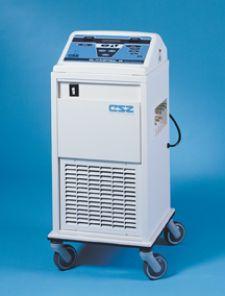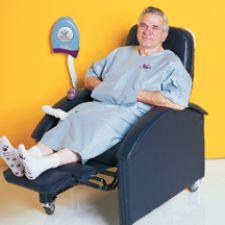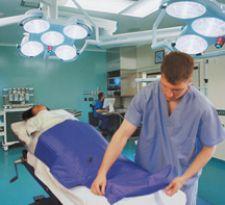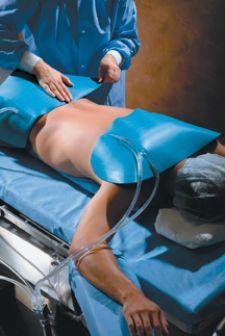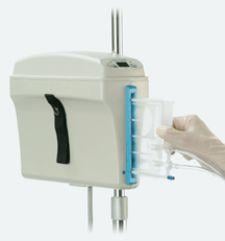
The Bair Paws forced-air hospital gown from Arizant Healthcare.
It may seem like a simple concept, but the importance of properly controlled patient temperature is still surprising clinicians in the OR today. In fact, the inventor of Bair Hugger forced-air warming — the first system of its kind and now an industry standard — believes the medical community is on the verge of an “explosion” in new products and technologies in temperature management.
Scott Augustine, M.D., founder of Augustine Biomedical Design (Eden Prairie, MN), says one major reason behind the trend is because Medicare will soon start mandating it.
“There are three things [Medicare] is looking at as outcomes that will affect your payment as a doctor,” Dr. Augustine said — those requirements being patient temperature and its role in the recovery room, pain control and wound infections.
“Interestingly, all three of those are affected by patient warmth,” he said. “When the government starts mandating it, it happens fast.”
When Dr. Augustine founded Bair Hugger and his former company, Augustine Medical (now Arizant Healthcare) in 1987, he says temperature management wasn’t nearly as recognized as the life-saving practice it is today.
“Nobody really cared about it,” he said. “It was really the large amount of research we did as a company that showed how a couple degrees of hypothermia causes a three-time increase in wound infections, which is huge,” he said.
There is also new research by organizations such as the Surgical Care Improvement Project (SCIP), 100K Lives Campaign and AORN that aim to improve infection rates in hospitals, specifically surgical site infections, according to Judson Boothe, associate marketing director of Surgical Solutions at Kimberly-Clark Health Care (Dallas, TX).
“What’s interesting is the second most mentioned item after antibiotic therapy is maintaining normothermia,” Boothe said. “It is one of the most controllable things that you can do to improve the patient’s ability to fight off an infection.”
New Developments
Companies are responding to the trend with a number of products and additions that make it easier to keep patients at a steady and appropriate temperature before, during and after surgery.
Forced-Air vs. Conduction
Arizant Healthcare’s (Eden Prairie, MN) Bair Paws forced-air hospital gown recently received FDA clearance for clinical warming, according to its marketing communications manager Troy Bergstrom.
“The Bair Paws system is different… because it offers both comfort and clinical warming capabilities throughout the perioperative process,” he said.
Patients wearing the gown in pre-op have the ability to control the temperature, Bergstrom said. This period of prewarming also allows them to "bank heat" before they enter the OR.
“As little as 15 minutes of prewarming can be effective in countering the temperature drop caused by the induction of anesthesia,” he said. “In the OR, the same gown can be connected to the Bair Hugger warming unit for clinical warming capabilities.”
Dr. Augustine says the future of temperature management is in conduction and radiation, which is the concept behind Augustine Biomedical Design’s new Hotdog Patient Warming System.
“What we are using for the heater is a conductive fabric,” he said. “It is just a piece of cloth that is specially treated so that when you run electricity through it, it becomes a heater.”
The system is difficult to work with, he says, but is extremely effective in keeping even heat over a large area. Another advantage is that it is less disruptive than forced-air units.
“There is no blower and no noise,” Dr. Augustine said. “It is a half-inch thick instead of two-and-a-half inches thick, and with no air blowing around you can start the heating process immediately rather than wait for a drape.”
The blankets don’t blow off because they aren’t inflated and use less energy, he added.
Flexible Temperature Control
The Medi-Temp III blood and fluid warmer from Gaymar Industries (Orchard Park, NY) maintains temperatures between 38 degrees and 43 degrees Celsius at flow rates of up to 500 mL per minute.
This adjustable set point temperature is what Brian Stelley, Gaymar’s senior marketing manager of Temperature Management, says sets the Medi-Temp III apart from other fluid warmers on the market.
“It gives the clinician some flexibility depending on the type of patient, such as a pediatric patient versus an adult patient,” he said. “It also allows the flexibility for the warmer to be used outside the operating room.”
The Medi-Temp III uses sterile disposable, non-pyrogenic, latex-free cassettes that provide even heat and can be easily mounted to an IV pole stand.
Gaymar’s line of temperature management products includes the Thermacare patient warming system, which features a lightweight, portable, warm-air blower unit with three temperature settings for the OR/ICU and the Medi-therm III hyper/hypothermia unit.
Cincinnati Sub-Zero (CSZ) (Cincinnati, OH) just released the microprocessor controlled Blanketrol III total body hyper-hypothermia water therapy system, which has the same heater and flow rates as the Blanketrol II but with several new features.
CSZ’s director of Sales and Marketing, Dave Fredrick, says the preset-variable and programmable variable gradient is the Blanketrol III’s most unique feature.
“It allows you, in an automatic mode, to dial in a temperature offset,” he said. “What that means is you can select the temperature difference between the patient and the water temperature.”
That’s important because it can be used on different patient populations and needs, he said, allowing anywhere from a five to 40 degree Fahrenheit difference.
“The unit will constantly maintain that temperature offset as that patient’s temperature increases or decreases,” he said.
Another system feature is SMART mode, which adjusts the gradient temperature five degrees Celsius if the desired patient temperature isn’t reached within 30 minutes. The system continues to monitor and adjust the temperature every 30 minutes until the temperature is reached.
Complex Surgery
Kimberly-Clark’s Patient Warming System is particularly useful in patients undergoing lengthy and complex surgery or when there’s not enough surface area to effectively manage them with a forced-air product, according to Boothe.
“You need something with the ability to put more energy per unit area into the patient,” he said. “That’s where technology such as ours has really changed the market.”
The system’s control unit draws temperature-controlled water through disposable gel pads applied directly to the patient’s body. In automatic mode, the control unit analyzes the patient’s rate of temperature change.
“It’s a water circulating system with a general pad that adheres to thepatient,” Boothe said. “It’s much like taking an electrode for a common electrocautery pad and putting a water jacket on the back, so you provide some warmth through that pad.”
Heat is conducted directly through skin via three-layer, nonslip hydrogel pads. Because the primary mode is water, there is no air blowing or leakage, Boothe said.
“The system operates under a vacuum so that if there is ever a breach, it actually pulls air into the system rather than leaking any fluid out,” he added.

